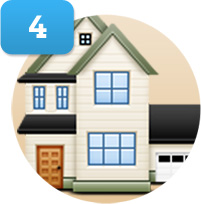Like most states, Texas has dealt with more than its fair share of wildfires in recent years. While the risk is not as bad today as it was a few years ago, wildfires are still a major threat to many Texas homes. This is why you need to make sure your homeowners insurance policy gives you ample protection against the risk of wildfires!
Why Homeowners Insurance is Important in Areas of High Fire Danger
Most ordinary homeowners insurance policies in Texas cover fire damage without regard to the origin of the fire. Wildfires deserve special consideration since they transcend ordinary misfortune for individual homeowners and enter into the realm of natural disasters. Recovering in the aftermath of a wildfire is more challenging (and often more expensive) than recovering from an ordinary fire! If you know your home is situated in an area where wildfires are a real risk, it’s a smart idea to ensure that you’re getting the protection you need from your homeowners insurance. Look carefully at the provisions regarding damage to possessions and property as well as your home itself; if your home is destroyed by a wildfire everything inside it will be lost as well!
The Changing Nature of Wildfires
Weather throughout North America is getting warmer and drier over time. Population growth and agricultural expansion are putting severe strains on water supplies. All of this translates into an environment that’s much friendlier to wildfires. When fires do start, they’re often whipped into a frenzy by exceptionally strong winds.
Fires start more frequently today and tend to grow larger and burn longer. The particular areas at risk change over time; California appears to be the state in the “hot seat” at the moment. While fire danger in Texas has dropped significantly from its all-time high in 2011-2012, it’s still far higher than it was in the 20th century.
Bastrop 2011: A Worst-Case Scenario
If you were living in central Texas in 2011, you don’t need anyone to tell you how destructive and dangerous wildfires can be! Multiple wildfires tore through Bastrop County in early September, leaving catastrophic damage and two dead bodies in their wake. The total damage caused by the Bastrop fires is incalculable. Insurance companies paid for more than $300 billion in claims on homeowners insurance policies. More than 1,500 homes were destroyed, and thousands of families had to disperse into surrounding communities for an extended stay. Homeowners insurance proved to be an enormous asset to the people affected by the Bastrop fires!
Insurers treated the situation like any other large-scale natural disaster, moving in well before the firefighting work was complete. They helped their homeowners insurance policy holders relocate for short- and long-term evacuations, cut checks immediately to help with expenses, and paid out generously to families who needed their assistance in rebuilding. At the end of 2011, despite the unprecedented number of claims filed for the Bastrop fires, only 11 homeowners filed disputes with the Texas Department of Insurance regarding their homeowners insurance.
Homeowners Insurance Helps you Even if you have No Damage
Wildfires start to have an economic impact on your family long before the flames arrive at your property. Thanks to its experiences in the past, Texas takes no chances when it comes to wildfires. Evacuations are called well in advance and every effort is made to clear the areas that are at risk. A good homeowners insurance policy should start benefiting you the moment you need to evacuate.
In the insurance industry, the cost of evacuation falls under the category of “additional living expenses,” commonly referred to as ALE. A good homeowners insurance policy in an area with a known risk of wildfires must include ample allowances for ALE payments! With a major disaster like a wildfire, insurers are often instructed by governmental authorities to pay out ALE to people with homeowners insurance regardless of the details of their policies. You shouldn’t rely on this, though; make sure your homeowners insurance will provide a long-term safety net.
Preparing your Property
If you live in an area that’s especially prone to wildfires, you can make some smart long-term adjustments to reduce your personal risk. Besides protecting your property, you might save some money on your homeowner’s insurance! Clear out trees around your home to create a firebreak. Thirty feet of open ground between your home and any heavy vegetation will make the building much safer. Look into fire-resistant plant species for the area around your home, and prevent any branches from overhanging your roof.
If you keep fire danger in mind while building or renovating your home you can make a strong case for lower premiums on your homeowners insurance. Double- or triple-glazed windows will resist the heat of wildfires better, and proper material selection can ensure that your roof achieves fire-resistance of “Class B” or better. Consult the National Fire Protection Association (NFPA) for more details.
Even though wildfire risks in Texas have been dropping, they’re still not anywhere near what could be considered “safe.” If you make sure your homeowners insurance and your property are both prepared to handle a major fire, you’ll feel that much more secure when the weather turns hot and dry and the wind comes up!





